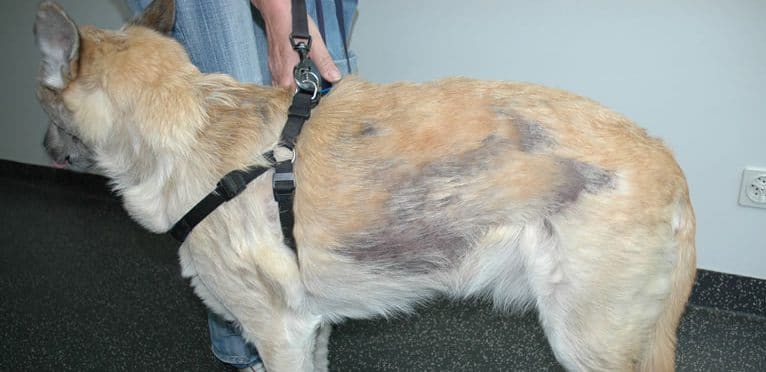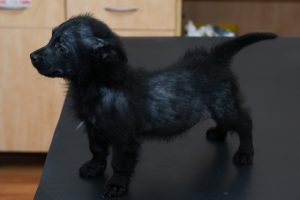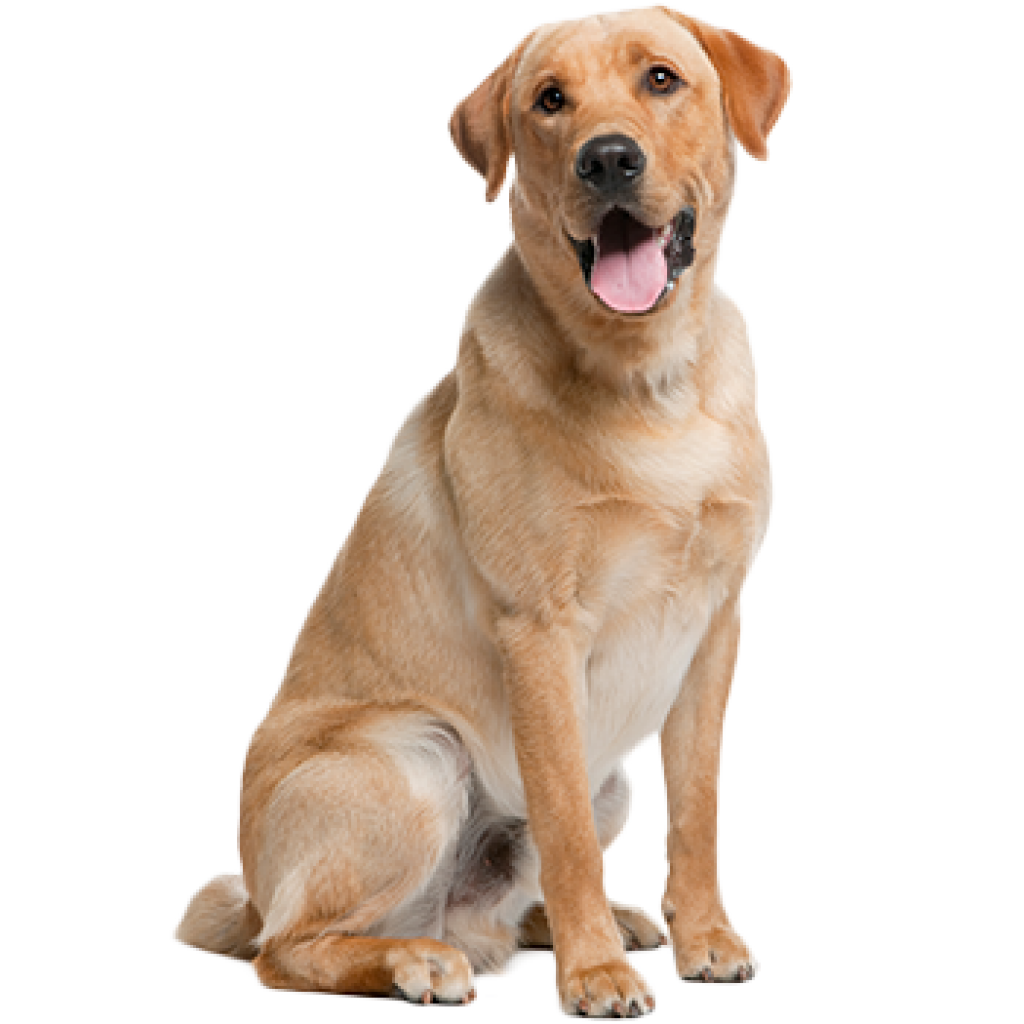Alopecia in Dogs
Free Pet Insurance Comparison
Compare Quotes From Top Companies and Save
Secured with SHA-256 Encryption

Dr. Pippa Elliott BVMS, MRCVS
Veterinarian
Dr Pippa Elliott BVMS, MRCVS is a veterinarian with over 30 years of experience in companion animal practice. In 1987 she graduated from the University of Glasgow, with a degree in veterinary medicine and surgery. She works at Blythwood Vets and the People’s Dispensary for Sick Animals (PDSA). Pippa is an advocate of Fear-Free Practice, an animal addict, and a veterinary writer. She is also w...
Veterinarian
UPDATED: Feb 3, 2025
Pet Insurance U receives compensation from the third parties included on this site. This includes payment for clicks from our site to insurance providers’ sites and quote requests generated. Our rankings and reviews are not affected by payments from the insurance companies. The compensation we receive allows the site to be free and regularly updated. Our goal is to review every pet insurance provider, but not all companies are listed on the site.
And many of the companies we review do not pay us anything. We simply rate, compare and review their plan because we feel it will be valuable to you. Our reviews are guaranteed to be unbiased, professional and advertising compensation does not influence rankings.
We are a free online resource for anyone interested in learning more about pet insurance. Our goal is to be an objective, third-party resource for everything pet insurance related. We update our site regularly, and all content is reviewed by pet insurance experts.
UPDATED: Feb 3, 2025
Pet Insurance U receives compensation from the third parties included on this site. This includes payment for clicks from our site to insurance providers’ sites and quote requests generated. Our rankings and reviews are not affected by payments from the insurance companies. The compensation we receive allows the site to be free and regularly updated. Our goal is to review every pet insurance provider, but not all companies are listed on the site.
And many of the companies we review do not pay us anything. We simply rate, compare and review their plan because we feel it will be valuable to you. Our reviews are guaranteed to be unbiased, professional and advertising compensation does not influence rankings.
On This Page
Hair loss in dogs, also called Alopecia, is a common disorder that results in either partial or complete hair loss.
Alopecia can affect a dog’s skin, immune system, endocrine, and even lymphatic systems.
Dogs of any age or breed can experience partial or complete hair loss.
When a dog experiences hair loss, it is usually indicative of other medical issues.
One of the most common causes of hair loss is an allergic reaction to fleas and can be treated with topical flea treatments and removal of fleas from the environment.
Need Pet Insurance?
FACT: Pet insurance pays up to 90% of vet bills when your pet is sick or injured!
Symptoms of Hair Loss in Dogs
If your dog has any of the following, it could be an indicator of Alopecia:
- Black or dark grey skin under hair loss
- Bleeding around area of hair loss
- Dry, scaly skin around the area of hair loss
- Foul odor
- Itchiness
- Overall thinning of the hair
- Patches of skin without hair
- Red, inflamed skin around the area of hair loss
Enter your ZIP code below to view companies that have cheap pet insurance rates.
Secured with SHA-256 Encryption
What Causes Hair Loss?

There are many different causes of hair loss in dogs and include the following:
- Allergies (e.g. Fleas, Food)
- Abnormal Organ Function
- Bacterial Infection
- Chemotherapy
- Cushing’s Disease
- Diabetes
- Fungal Infection (Ringworm)
- Insect Bites
- Mites (Mange)
- Nervous Licking
- Anxiety
- Pressure Sores
- Recent Vaccination
- Excessive of Lack of Hormones
- Sex Hormone Imbalance
- Skin Cancer
- Thyroid Disorder
- Trauma and/or Scarring
- Infection
- Skin Parasites
- Poor Nutrition
One of the most common causes of alopecia is Mange which is caused by a Demodex mite.
When mange occurs, the mite will invade the hair follicles and skin of the dog which can lead to skin lesions and hair loss.
Related: 10 Things You Must Know Before You Buy Pet Insurance
Infection, trauma, immune disease, and endocrine system abnormalities will also cause hair loss.
When there are missing patches of hair, it is usually associated with inflammation of the hair follicle
A widespread area of hair loss will usually occur if there is a more specific disease.
Diagnosis of Alopecia
Hair loss in dogs can be caused by many different medical and even behavioral problems.
Your vet will conduct a thorough physical exam to determine the cause and could include the following:
- Skin Scrapings
- Combing for
- Skin scrapings/biopsy
- Hair culture for fungal growth
- Blood test
- Urinalysis
- X-rays
Your vet will also look at the pattern of the missing hair which can help diagnose the cause:
Multiple Areas with Loss of Hair
When there are multiple areas and reddening of the skin, it will usually be a fungus or bacterial infection. Scleroderma, a skin condition, as a result of vaccination can cause hair loss.
Symmetrical Loss of Hair
When there is a symmetrical pattern of hair loss, it usually indicates low thyroid levels or any adrenal issue.
Patchy Loss of Hair
Mange is the usual culprit with this pattern of hair loss. Other causes are bacterial infections and ringworm.
Breeds That Are Susceptible to Hair Loss
There are some breeds where hair loss is more common:
- Dachshunds – thinning around the ears
Hair Loss due to Thyroid disease:
- Afghan
- Boxer
- Chow Chow
- Cocker Spaniel
- Doberman Pinscher
- English Bulldog
- Golden Retriever
- Great Dane
- Irish Setter
- Newfoundland
- Poodle
- Schnauzers (Miniature and Large)
- Sheepdogs
Real Cost Savings from PetFirst Clients

Luna
PetFirst saved his parents
$6,712
A happy energetic Luna one morning couldn’t hold her food down. After months of multiple costly vet visits to specialists and an endoscopy, the problem was discovered and fixed. Luna put 22 pounds back on in no time and her parents were grateful for having PetFirst by their side to pay the bills.
Enter your ZIP code below to view companies that have cheap pet insurance rates.
Secured with SHA-256 Encryption
Alopecia Treatment
The treatment for the loss of hair will depend on the underlying cause.
Topical antibiotics (or oral) and antifungals will be used to treat bacterial infections and antifungals
Dogs who have allergies might need a hypoallergenic diet.
For fleas and mange, a topical anti-parasitic drug and specialized shampoos can help.
Dogs that have endocrine disorders, such as Cushing’s disease will require hormonal treatment.
If there is any growth or skin cancer, it is usually surgically removed.
Can Pet Insurance Help with Hair Loss?
The cost of treating hair loss, of course, depends on what is the underlying cause.
The typical costs can range anywhere from $50 to $2,000.
Pet insurance can help with the testing, X-rays, labs or any of the treatment that is required from a disease that has caused the hair loss.
Plans like Healthy Paws will cover up to 90% of the costs as long as the condition isn’t pre-existing.
If fleas or mites are causing the hair loss, wellness plans that help cover routine care costs like flea treatment can help offset some of those costs.
Alopecia Recovery
Depending on the severity of the hair loss, the treatment can really help with the cause and the hair should grow back.
It’s important to watch the dog’s skin to make sure it doesn’t become infected.

Enter your ZIP code below to view companies that have cheap pet insurance rates.
Secured with SHA-256 Encryption
Prevention of Alopecia
The best way to prevent hair loss in your dogs is to watch for any of the signs and or skin issues that might cause the hair loss.
For more information on some of the diseases that might cause hair loss, our dog health glossary is a good place to start!
Other articles you may find helpful:
Is Exotic Pet Insurance Necessary?
The Best Pet Insurance By State
Fun Facts, Dog FAQ, And Unsolicited Dog Advice
5 Training Commands to Save Your Dog’s Life
The Ultimate Guide to Safe Foods for Dogs
We get it, your dog is like your child and when your puppy or dog has health problems it is scary. Luckily there is pet insurance companies that will help you pay for any veterinarian care they made need. Checkout the best puppy and dog pet insurance companies and learn about common puppy health issues and ailments in older pets.
Common Health Problems:
Chronic Active Hepatitis in Dogs
Cruciate Ligament Tear in Dogs
Degenerative Myelopathy | Spinal Cord Disease In Dogs
Dementia in Dogs | Canine Cognitive Dysfunction
Dog Comedones (Schnauzer Bumps)
Dog Diarrhea: What Can You Do To Help?
Gallbladder Obstruction in Dogs
Heart Murmurs In Dogs | How To Identify Them
Intervertebral Disc Disease In Dogs
Nasal Solar Dermatitis In Dogs
Progressive Retinal Atrophy In Dogs
The Dog Flu – Symptoms & Treatment for Canine Influenza
Frequently Asked Questions
What is Alopecia in dogs?
Alopecia, also known as hair loss, is a common disorder in dogs that results in either partial or complete loss of hair. It can affect a dog’s skin, immune system, endocrine, and lymphatic systems.
What causes hair loss in dogs?
Hair loss in dogs can be caused by various factors, including allergic reactions to fleas, mange caused by a Demodex mite, infections, trauma, immune diseases, and endocrine system abnormalities.
How can I recognize symptoms of hair loss in my dog
Symptoms of hair loss in dogs may include missing patches of hair, inflammation of hair follicles, and specific patterns of hair loss. These patterns can help in diagnosing the underlying cause.
Can pet insurance help with the treatment of Alopecia in dogs?
Yes, pet insurance can assist with the costs of diagnosing and treating Alopecia in dogs. Plans like Healthy Paws may cover up to 90% of the costs, depending on the underlying cause, as long as the condition isn’t pre-existing.
What are some common treatments for Alopecia in dogs?
Treatment for Alopecia in dogs depends on the underlying cause. It may include topical antibiotics or antifungals for infections, hypoallergenic diets for dogs with allergies, and specialized shampoos or anti-parasitic drugs for fleas or mange.
Are there specific breeds more susceptible to hair loss?
Yes, some breeds are more susceptible to hair loss, particularly due to thyroid disease. It’s essential to be aware of specific health issues associated with your dog’s breed.
Can Alopecia in dogs be prevented?
While it may not be entirely preventable, monitoring for signs of hair loss and addressing skin issues promptly can help catch and treat underlying causes early, reducing the severity of Alopecia.
How much does treating Alopecia in dogs typically cost?
The cost of treating Alopecia in dogs can vary widely, ranging from $50 to $2,000, depending on the underlying cause. Pet insurance can help cover the costs of testing, treatment, and other related expenses.
How long does it take for a dog to recover from Alopecia treatment?
The recovery time for Alopecia in dogs depends on the severity of hair loss and the underlying cause. With appropriate treatment, the hair should grow back, and it’s crucial to monitor the dog’s skin for any signs of infection.
Is pet insurance necessary for dogs with Alopecia?
Pet insurance can be valuable for covering the costs associated with diagnosing and treating Alopecia in dogs, especially if the condition is not pre-existing. It provides financial assistance for veterinary care and can contribute to the overall well-being of your pet.
Enter your ZIP code below to view companies that have cheap pet insurance rates.
Secured with SHA-256 Encryption
Dr. Pippa Elliott BVMS, MRCVS
Veterinarian
Dr Pippa Elliott BVMS, MRCVS is a veterinarian with over 30 years of experience in companion animal practice. In 1987 she graduated from the University of Glasgow, with a degree in veterinary medicine and surgery. She works at Blythwood Vets and the People’s Dispensary for Sick Animals (PDSA). Pippa is an advocate of Fear-Free Practice, an animal addict, and a veterinary writer. She is also w...
Veterinarian
We are a free online resource for anyone interested in learning more about pet insurance. Our goal is to be an objective, third-party resource for everything pet insurance related. We update our site regularly, and all content is reviewed by pet insurance experts.
